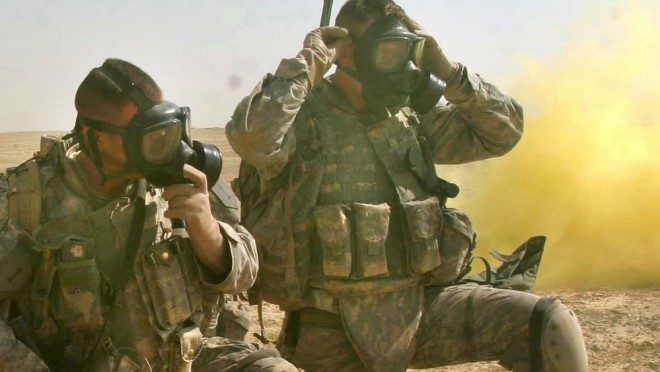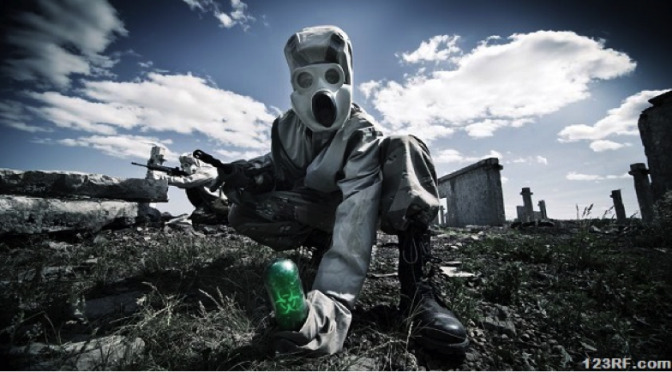NAFAC Week
By Sam Klein
While the United States funds by far the most biomedical research in the private and public sectors, its investment in this space has declined in recent years, as has its share of the total global investment.1 This decrease stands in stark contrast to the growing threat of biological weapons of mass destruction; there is “reason for concern that future bioterrorism attacks may be more effective than incidents in the past, and disease control facilities in other countries may not be as robust as those in our own.”2,3 While biological weapons research is a subset of all biological research, the downward trend in the greater field is not promising; the field must be considered holistically as epidemiology, immunology, and related subfields that can inform biological attack response even if they are not all classified as biological weapons defense research. Because the United States’ biological WMD preparedness is inadequate, the United States government should substantially increase its investment in biological weapons response, including private- and public-sector biomedical research, treatment coordination infrastructure, and intelligence-driven threat mitigation.4
Need for Research
The United States government should invest at least $155.8 billion next year in public research and private research grants, corresponding to our 2007 figure adjusted for inflation. This was the demonstrated need in 2007, and the need is at least as large now as it was ten years ago given our present state of understanding and preparedness.5
Although general epidemiological research is certainly useful in preparing for a targeted outbreak, bioterrorism research must also include more focused analysis. Biological weapons of mass destruction can be qualitatively different from naturally-occurring outbreaks of disease, both in terms of how concentrated they are and in their mode of transfer. This difference can be to the extent that a weaponized pathogen is untreatable by conventional means such as vaccination, as even a naturally occurring analog would respond to treatment.6 Aerosolizing normally grounded biohazards can render existing epidemiology models of those materials dangerously misleading, as spreading could take place at a far faster pace than expected. These factors all demonstrate the need for dedicated biological weapons research.
In addition to infecting humans, bio-WMD can also attack a population indirectly, for instance via agriculture.7 Given increasing monoculture and despeciation (i.e. biodiversity loss) in U.S. agriculture, American food supply and agricultural byproducts (e.g. ethanol) are less resilient to targeted bioterrorism.
A recent (2013) network analysis of the American interdisciplinary approach to bioterrorism research and prevention sought to determine whether the research being produced was covering the bases necessary to produce positive public health outcomes in the event of an attack. It finds value in the decentralized nature of the American approach, but also calls for more interdisciplinary research collaboration and greater “development of discovery techniques that are specialized to bioterrorism and security research sources.”8 Further investment should be channeled to these areas in addition to general epidemiology research.
Treatment Coordination Infrastructure
In 2004, the Project Bioshield Act appropriated $5 billion for preparation against likely bioweapons such as anthrax and botulism. This investment included stockpiling millions of vaccines.9 While this is a good start, momentum for this sort of investment has died down in the absence of political pressure 15 years after 9/11.
Early detection of infection is critical to saving individual lives and identifying and limiting the spread of a biological weapon of mass destruction. This will invariably happen at the local level, so it is critical that doctors on the ground across the country are knowledgeable of the symptoms of deployable biohazards and that they have the ability to quickly report incidents up the chain of command.10 It is likewise critical that the government continue to invest in bio-WMD epidemiological modeling (distinct from traditional modeling, as stated above) and in infrastructure to track ground-level reports of symptoms with the capability of distinguishing an attack from a natural outbreak (which should be treated differently).
In 2011, the Department of Health and Human Services discontinued a program that outlined a comprehensive model of epidemic response with an emphasis on bioterrorism. The model, known as the Weill/Cornell Bioterrorism and Epidemic Response Model (BERM), was used by hospitals and epidemiologists.11 It has since been supplanted by CDC guidelines for epidemic response, but extensive research fails to yield a robust replacement that affords the same flexibility as BERM with regard to bioterror-specific cases.12 The government should invest in consolidating and refining the approach and publicizing it to the necessary channels as mentioned above.
Threat Mitigation
Finally, there is little publicly known intelligence on foreign state and non-state actor bioterrorism capabilities beyond the Congressional Research Service figure that12 several countries plus the United States have or have had biological weapons research programs (if not weapons themselves).13 This intelligence is extremely limited, in part because of the concealable nature of bio-WMD development. While procurement of some dangerous biological agents can be difficult outside of visible controlled facilities, others require less effort. However, the public may lack the fear and urgency needed to motivate policymakers to invest in biological weapons threat mitigation. In 2003, Colin Powell famously held a model vial of “anthrax” to the United Nations Security Council to make the case of invasion. While the Hussein regime was in fact weaponizing biological weapons including anthrax, simultaneous failures of U.S. intelligence cast a shadow on all of the WMD intelligence.14
One of the major deterrents to weaponizing biologics is the difficulty in controlling their spread; unlike conventional weapons and other WMD, biological weapons quite literally have “lives of their own” and, once deployed, could ostensibly infect the assailant’s population. However, one could conceive of a scenario in which the assailing population has been vaccinated so that the attack only affects the intended target.15
Conclusion
Biological weapons are a clear and present danger to the United States, and the country’s understanding of and preparation for an attack are grossly inadequate. Substantial increases in biological defense research, crisis management, and threat prevention are crucial to increase the security of American citizens.
Sam Klein studies political science and writing at Washington University in St. Louis, where he also serves as executive director of the Washington University Political Review. A native of Bethesda, MD, Sam is interested in domestic legislative politics and foreign affairs. In addition to the Political Review, he is involved in Model UN and student government. He intends to graduate in 2018.
Works Cited
Barker, Gary C. “Analysis of Research Publications that Relate to Bioterrorism and Risk Assessment.” Biosecurity and Bioterrorism: Biodefense Strategy, Practice, and Science 11, no. 1 (2013). doi:10.1089/bsp.2013.0019.
Chakma, Justin, Gordon H. Sun, Jeffrey D. Steinberg, Stephen M. Sammut, and Reshma Jagsi. “Asia’s Ascent — Global Trends in Biomedical R&D Expenditures.” New England Journal of Medicine 370, no. 1 (2014): 3-6. doi:10.1056/nejmp1311068.
Gerstein, Daniel M. “Countering Bioterror.” RAND Corporation. January 18, 2016. Accessed March 24, 2017. http://www.rand.org/blog/2016/01/countering-bioterror.html.
“Healthcare Preparedness Capabilities.” January 2012. Accessed March 25, 2017. https://www.phe.gov/Preparedness/planning/hpp/reports/Documents/capabilities.pdf.
Henderson, Donald A. “The Looming Threat of Bioterrorism.” Science 283, no. 5406 (1999): 1279-282. doi:10.1126/science.283.5406.1279.
Hupert, Nathaniel, Jason Cuomo, and Christopher Neukermans. “The Weill/Cornell Bioterrorism and Epidemic Outbreak Response Model (BERM).” Archive: Agency for Healthcare Research Quality. September 8, 2004. Accessed March 25, 2017. https://archive.ahrq.gov/research/biomodel3/index.asp.
Jansen, H. J., F. J. Breeveld, C. Stijnis, and M. P. Grobusch. “Biological warfare, bioterrorism, and biocrime.” Clinical Microbiology and Infection 20, no. 6 (June 2014): 488-96. doi:10.1111/1469-0691.12699.
Kerr, Paul K. Nuclear, Biological, and Chemical Weapons and Missiles: Status and Trends. Report. Congressional Research Service. February 20, 2008.
Madad, Syra S. “Bioterrorism: An Emerging Global Health Threat.” Journal of Bioterrorism & Biodefense 05, no. 01 (August 4, 2014). doi:10.4172/2157-2526.1000129.
Martin, James W., George W. Christopher, and Edward M. Eitzen, Jr. “History of Biological Weapons: From Poisoned Darts to Intentional Epidemics.” In Medical Aspects of Biological Warfare, edited by Zygmunt F. Dembek. Washington, DC: Borden Institute, Walter Reed Army Medical Center, 2007.
Pifer, Steven. “Interview with Amb. Steven Pifer.” Interview by author. March 31, 2017. “The White House.” National Archives and Records Administration. July 21, 2004. Accessed
March 25, 2017. https://georgewbush-whitehouse.archives.gov/infocus/bioshield/.
Weisman, Steven R. “Powell Calls His U.N. Speech a Lasting Blot on His Record.” New York Times, September 9, 2005.
References
1. Chakma, Justin, Gordon H. Sun, Jeffrey D. Steinberg, Stephen M. Sammut, and Reshma Jagsi. “Asia’s Ascent — Global Trends in Biomedical R&D Expenditures.” New England Journal of Medicine 370, no. 1 (2014): 3-6. doi:10.1056/nejmp1311068.
2. Jansen, H. J., F. J. Breeveld, C. Stijnis, and M. P. Grobusch. “Biological warfare, bioterrorism, and biocrime.” Clinical Microbiology and Infection 20, no. 6 (June 2014): 488-96. doi:10.1111/1469-0691.12699.
3. Henderson, Donald A. “The Looming Threat of Bioterrorism.” Science 283, no. 5406 (1999): 1279-282. doi:10.1126/science.283.5406.1279.
4. Chakma et al. “Asia’s Ascent.”
5. Pifer, Steven. “Interview with Amb. Steven Pifer.” Interview by author. March 31, 2017.
6. Gerstein, Daniel M. “Countering Bioterror.” RAND Corporation. January 18, 2016. Accessed March 24, 2017. http://www.rand.org/blog/2016/01/countering-bioterror.html.
7. Martin, James W., George W. Christopher, and Edward M. Eitzen, Jr. “History of Biological Weapons: From Poisoned Darts to Intentional Epidemics.” In Medical aspects of biological warfare, edited by Zygmunt F. Dembek. Washington, DC: Borden Institute, Walter Reed Army Medical Center, 2007.
8. Barker, Gary C. “Analysis of Research Publications that Relate to Bioterrorism and Risk Assessment.” Biosecurity and Bioterrorism: Biodefense Strategy, Practice, and Science 11, no. 1 (2013). doi:10.1089/bsp.2013.0019.
9. “The White House.” National Archives and Records Administration. July 21, 2004. Accessed March 25, 2017. https://georgewbush-whitehouse.archives.gov/infocus/bioshield/.
10 Madad, Syra S. “Bioterrorism: An Emerging Global Health Threat.” Journal of Bioterrorism & Biodefense 05, no. 01 (August 4, 2014). doi:10.4172/2157-2526.1000129.
11. Hupert, Nathaniel, Jason Cuomo, and Christopher Neukermans. “The Weill/Cornell Bioterrorism and Epidemic Outbreak Response Model (BERM).” Archive: Agency for Healthcare Research Quality. September 8, 2004. Accessed March 25, 2017. https://archive.ahrq.gov/research/biomodel3/index.asp.
12 “Healthcare Preparedness Capabilities.” January 2012. Accessed March 25, 2017. https://www.phe.gov/Preparedness/planning/hpp/reports/Documents/capabilities.pdf.
13 Kerr, Paul K. Nuclear, Biological, and Chemical Weapons and Missiles: Status and Trends. Report. Congressional Research Service. February 20, 2008.
14 Weisman, Steven R. “Powell Calls His U.N. Speech a Lasting Blot on His Record.” New York Times, September 9, 2005.
15 Pifer, Steven. “Interview.”
Featured Image: Credit U.S. Army





